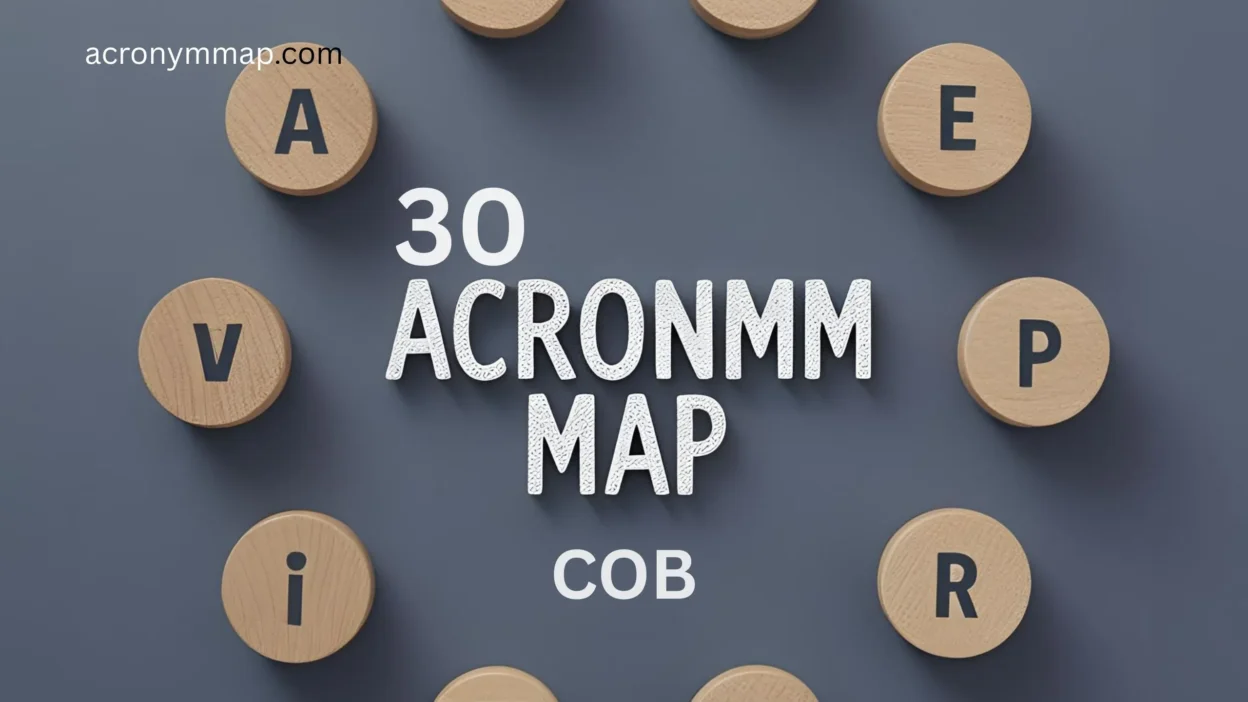When someone hears the term “COB acronym,” the first thing that often comes to mind is the business phrase “Close of Business,” commonly used in corporate emails to set deadlines (e.g., “Please send the report by COB today.”). But what if we zoom out and explore COB not just as a work-related term, but symbolically?
Let’s redefine COB as a metaphor for Closure, Order, and Boundaries—traits that represent structure, discipline, and finality. This symbolic usage applies to people who are organized, deadline-driven, and value clarity and control—whether emotionally, professionally, or socially.
In this article, we’ll explore 30 alternative acronyms or terms that reflect the essence of “COB” and explain when and how to use each depending on the tone, context, and emotional nuance of your message.
🧾 What Does “COB” Mean?
Literal Use:
- COB = Close of Business
- Meaning: The end of the business day, typically 5:00 or 6:00 PM local time.
- Example: “Kindly submit the design draft by COB Friday.”
Metaphorical Use (in this article):
- COB = Closure, Order, Boundaries
- Traits: Organized, methodical, structured, deadline-focused
🧠 30 Alternatives to the “COB Acronym” (Closure | Order | Boundaries)
1. EOD (End of Day)
Meaning: Same as COB; often interchangeable.
Example: “I’ll review the documents by EOD.”
When to use: Casual or tech/startup environments.
2. Deadline
Meaning: A fixed time for task completion.
Example: “The deadline for submissions is Tuesday.”
When to use: When emphasizing urgency or pressure.
3. Cutoff
Meaning: Final point for action or acceptance.
Example: “The cutoff for applications is midnight.”
When to use: Sharp, absolute tone.
4. Due
Meaning: Expected time for completion.
Example: “The invoice is due next week.”
When to use: Formal or administrative writing.
5. Wrap-up
Meaning: Conclude or finalize something.
Example: “Let’s wrap up this project by Friday.”
When to use: Casual team environments.
6. Final call
Meaning: Last opportunity before closure.
Example: “Final call for RSVPs!”
When to use: Informal or marketing tone.
7. Deliverable
Meaning: A completed task or product.
Example: “Is the deliverable ready for review?”
When to use: Project-based or contract work.
8. Sign-off
Meaning: Official approval or completion.
Example: “We need client sign-off before launch.”
When to use: Corporate and agency settings.
9. Milestone
Meaning: A key progress point.
Example: “Reaching 1,000 users was a major milestone.”
When to use: Progress tracking or strategic discussions.
10. Checkpoint
Meaning: A moment to review progress.
Example: “We’ll meet again at the next checkpoint.”
When to use: Ongoing project phases.
11. Closure
Meaning: The act of completing or ending something.
Example: “We need closure on this account.”
When to use: Emotional or business resolutions.
12. Timebox
Meaning: A fixed time to do a task.
Example: “Let’s timebox the meeting to 30 minutes.”
When to use: Agile or productivity contexts.
13. Lock-in
Meaning: A firm decision or commitment.
Example: “We need to lock in the schedule.”
When to use: Planning or strategic commitments.
14. Hard stop
Meaning: Non-negotiable end time.
Example: “I have a hard stop at 4 PM.”
When to use: Meetings and calls.
15. Timeline
Meaning: Overall schedule or plan.
Example: “Can you share your project timeline?”
When to use: Broad planning conversations.
16. Window
Meaning: A limited time frame.
Example: “We have a short window to finalize.”
When to use: Flexible but urgent situations.
17. ETA (Estimated Time of Arrival)
Meaning: Predicted completion time.
Example: “What’s the ETA on the mockups?”
When to use: Tech and logistics.
18. Checkpoint
Meaning: Intermediate review stage.
Example: “Next checkpoint is Monday morning.”
When to use: Long-term project tracking.
19. Kickoff
Meaning: Start of a task or project.
Example: “Kickoff is scheduled for next week.”
When to use: Paired with COB for project framing.
20. Sign-out
Meaning: Ending presence or contribution.
Example: “I’ll sign out after submitting the file.”
When to use: Casual or shift-based work.
21. Checkpoint Complete
Meaning: Milestone verified and done.
Example: “Checkpoint complete, moving to next phase.”
When to use: Status updates.
22. Final stage
Meaning: Last phase of a process.
Example: “We’re in the final stage of review.”
When to use: Critical delivery points.
23. Closeout
Meaning: Ending process in operations or projects.
Example: “Let’s begin project closeout procedures.”
When to use: Formal completion.
24. Sign-off point
Meaning: Designated moment for final approval.
Example: “This is the sign-off point for all assets.”
When to use: Corporate workflows.
25. Shutoff
Meaning: A decisive or automatic end.
Example: “System shutoff happens after COB.”
When to use: Tech, security, or infrastructure.
26. Rollout
Meaning: Begin release or launch.
Example: “The product rollout starts post-COB.”
When to use: Marketing and product teams.
27. Completion
Meaning: Task fully finished.
Example: “We’re nearing task completion.”
When to use: General purpose term.
28. Closure Date
Meaning: Official end day.
Example: “Set a closure date for the project.”
When to use: HR, operations, and contracts.
29. Freeze
Meaning: No further changes allowed.
Example: “Design freeze starts tomorrow.”
When to use: Product, code, or creative deadlines.
30. Finalization
Meaning: Final steps in process.
Example: “We’re in finalization mode now.”
When to use: Wrapping up formalities.
📊 How to Pick the Right Alternative
When deciding which term to use instead of “COB,” think about:
- Urgency: “Deadline,” “cutoff,” and “hard stop” create pressure.
- Tone: “Final call” sounds friendly; “lock-in” or “freeze” sound firm.
- Formality: “Closure” or “finalization” suits official reports, while “wrap-up” works for emails.
- Workflow Stage: Use “kickoff” and “rollout” early on; “closeout” and “sign-off” toward the end.
✅ Conclusion
Whether you’re managing projects, setting expectations, or planning personal goals, language that reflects structure and clarity—like COB and its alternatives—adds confidence and professionalism to your communication.
Think of “COB” as more than a timestamp; it’s a mindset of closure, order, and boundaries. Choosing the right synonym enhances clarity, shows respect for people’s time, and makes your writing sharper and more effective.

